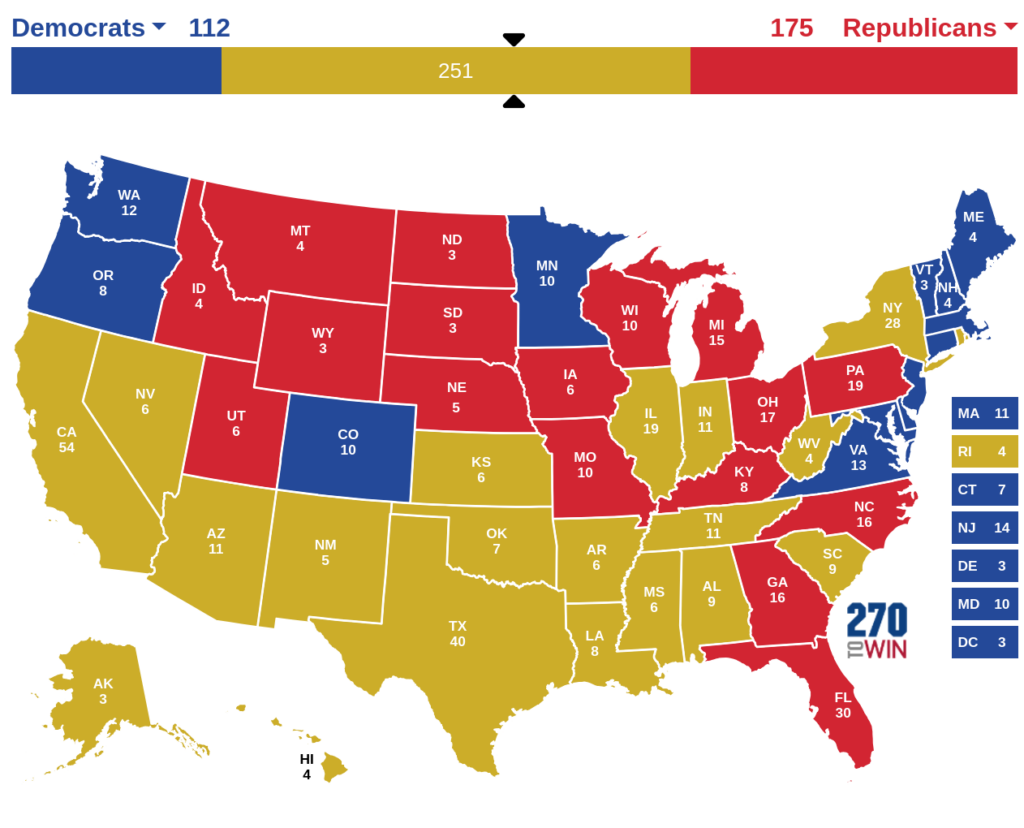In just the first two weeks, the second Trump administration has implemented drastic and far-reaching changes in the US. The Trump Administration has justified their swift course of radical actions based on claims of some decisive electoral mandate. In his November 2024 victory speech, Donald Trump said that “America has given us an unprecedented and powerful mandate,” and in a more recent interview with Time Magazine, he stated that “the beauty is that we won by so much. The mandate was massive.”
But viewed in proper perspective, the election results do not signify any sort of electoral mandate. In my view, the best illustration of electoral authorization accounts for the total voting-eligible population. Estimates from the University of Florida’s Election Lab on the number of eligible voters make clear that the most popular option in 2024 was, in fact, not voting at all.

Though more voters did cast ballots for Trump than did for Harris, a significantly larger number decided not to cast a ballot at all. It seems inappropriate to frame the 2024 outcome as a powerful mandate for Trump’s agenda when less than a third of eligible voters voiced support for it. And the thin gap between Harris and Trump stands at less than one percentage point of the total voting-eligible population. A fairly small shift in who showed up to vote or who voted for other third party candidates could easily have changed the outcome of the popular vote.
Another way to view this is state-by-state. Taking inspiration from u/Snoo_48369 on Reddit, here is an Electoral College map showing the results of the 2024 election, if No Vote was a candidate in the race. Candidate No Vote would have won more electoral votes than did Trump or Harris.

The state-level data does not look like a powerful mandate either. I think this is helpful to keep in mind. It is not obvious that most people in the US support Trump’s agenda, and from these election results it seems unlikely that more than half of the voting-eligible population affirmatively supports him. Even looking only at votes cast, Trump received less than 50% of the popular vote. Trump was successful in garnering more votes than Harris in the right geographies, but that is distinct from a “powerful mandate.” Rather than a broad electoral endorsement of Trump’s agenda, the results presented here are just as consistent with a voting population that is largely disaffected and discontented with US politics.
2024 was No Landslide
Other analysts have pointed out how, in historical context, the 2024 General Election was a razor-thin win for the Republican Party. James Lindsay at the Council on Foreign Relations offered that a useful way to evaluate whether an election was a landslide is to look at how many popular votes would need to shift to change the outcome of the electoral college. He finds that “If Harris had picked up the right mix of 229,726 votes in Michigan (80,103), Pennsylvania (120,226), and Wisconsin (29,397), she would be taking the oath of office on January 20.” Given that over 150 million votes were cast in the presidential electron, a shift of 230 thousand votes seems almost arbitrary.
PolitiFact puts the 2024 margin in context: “For votes counted through Nov. 20, Trump’s margin over Harris was 1.62 percent. That’s smaller than any winner since Bush in 2000, when the margin was 0.51 percent. Going back further, only John F. Kennedy in 1960 and Nixon in 1968 won the popular vote by smaller margins, 0.17 percent and 0.7 percent, respectively.” Domenico Montanaro points out the implication that “Trump’s popular-vote margin was the second-narrowest in the last 60 years.”
And congressional election outcomes reflected even thinner margins than in the presidential contest. PolitiFact explained that “Of the seven battleground states, five also held Senate races and one had a gubernatorial contest. The Republican candidate won Pennsylvania’s Senate race, but the Democrat won the Senate races in Arizona, Michigan, Nevada and Wisconsin, and the gubernatorial contest in North Carolina.” The Senate thus remains only narrowly controlled by Republicans. And NPR’s Montanaro also reports that “Control of the House was so close that it came down to just 7,309 votes in three congressional races, according to the Cook Political Report’s David Wasserman.”
Building a more robust system
The fact is that the 2024 general election was no landslide. Slightly different circumstances could have led to a different outcome. And given the state of the two major parties, a different outcome would mean a drastically different trajectory for the country. If small, almost arbitrary perturbations to an election lead a country down divergent and even antithetical paths, that is a fragile election system. A fragile election system is not desirable. We need to be asking how to build an election system that is robust.
A robust election system is one that better reflects the will of the voters, has a high level of engagement, and small changes in the actual vote should not lead to drastically different policy trajectories across the board. The current election system in the US is quite poor at discovering what issues and priorities the electorate actually care about. And it has a critical problem that a small number of people in a few select places can put the country on paths that are poles apart.
Election reform efforts would provide a more robust system. Policies like ranked choice voting and proportional representation would improve the electoral system to better reflect voter’s preferences and yield more robust political outcomes. Groups doing the critical work of advocating for these reforms include FairVote, Unite America, and the Center for Election Science. Recent years have seen some electoral reform progress, but sustained and broad work to implement more of these reforms is as urgent and important as ever.